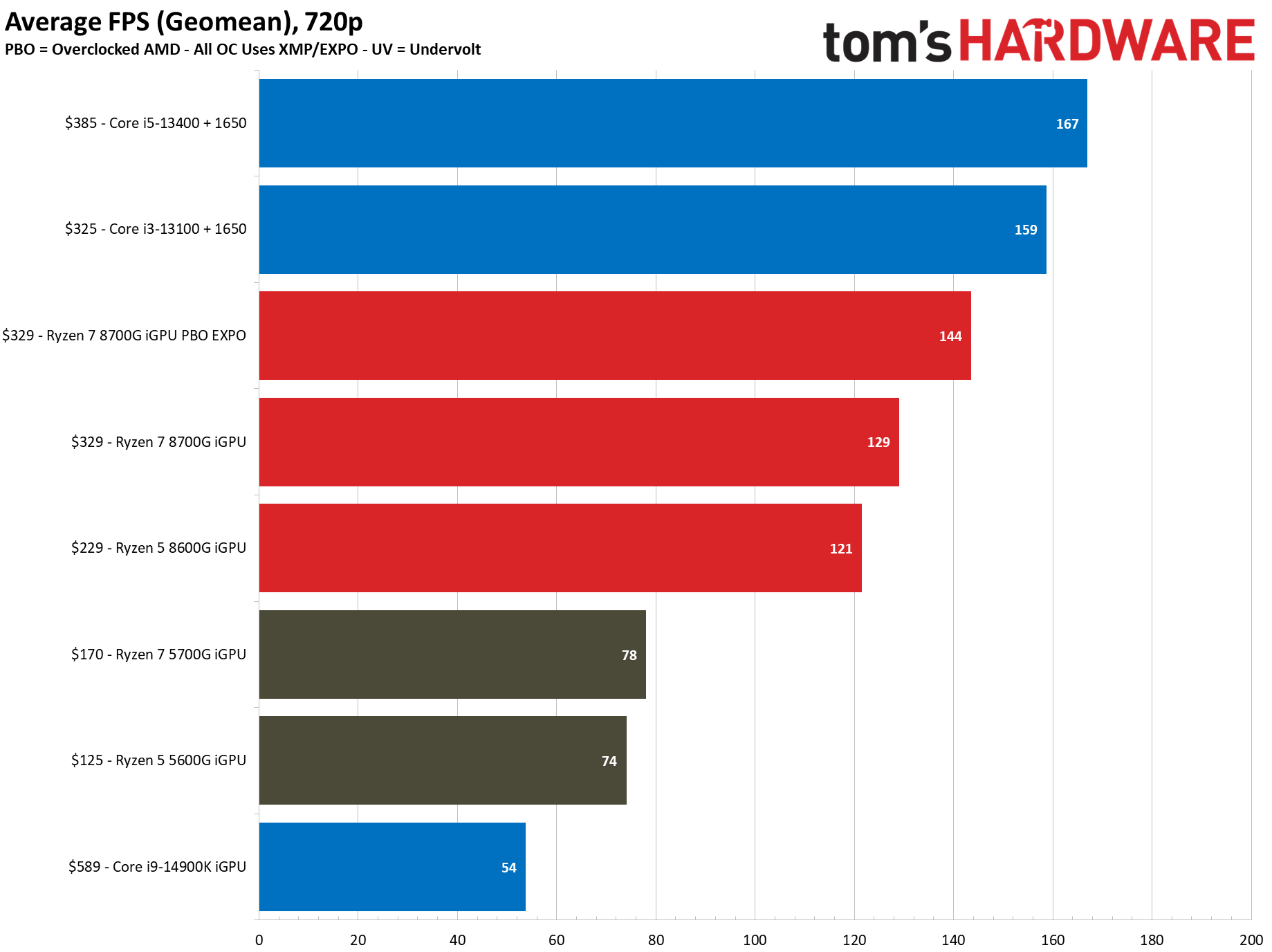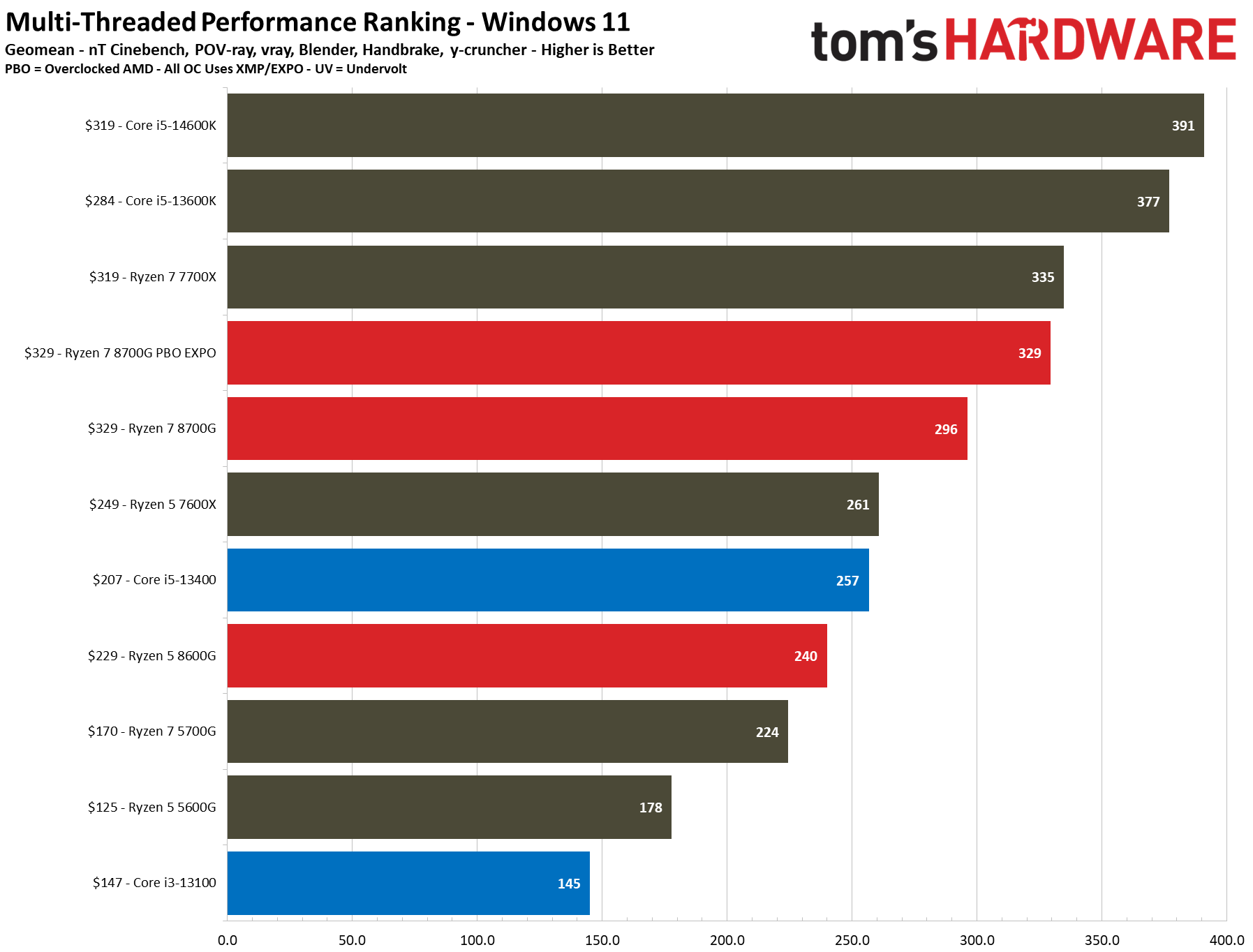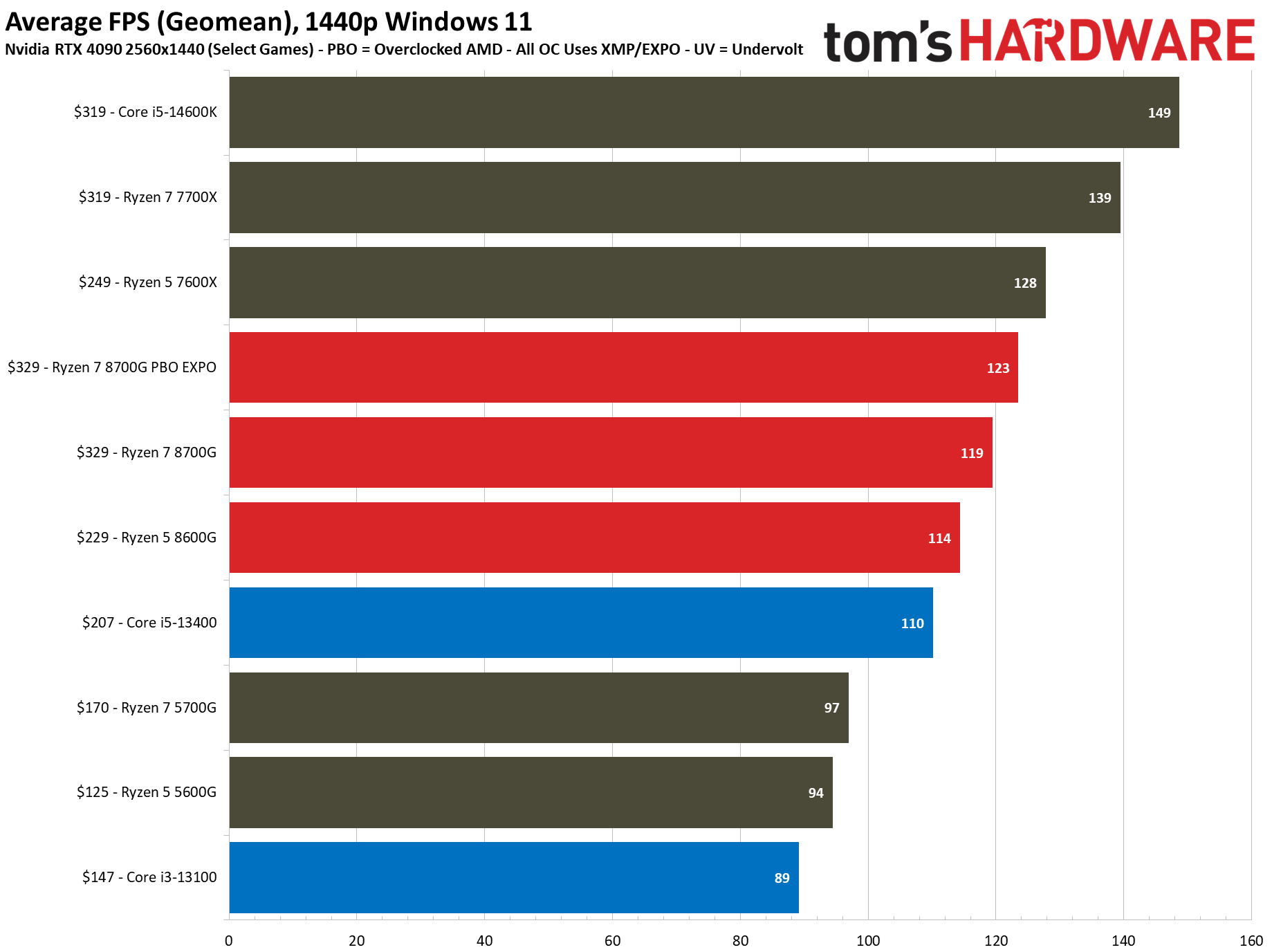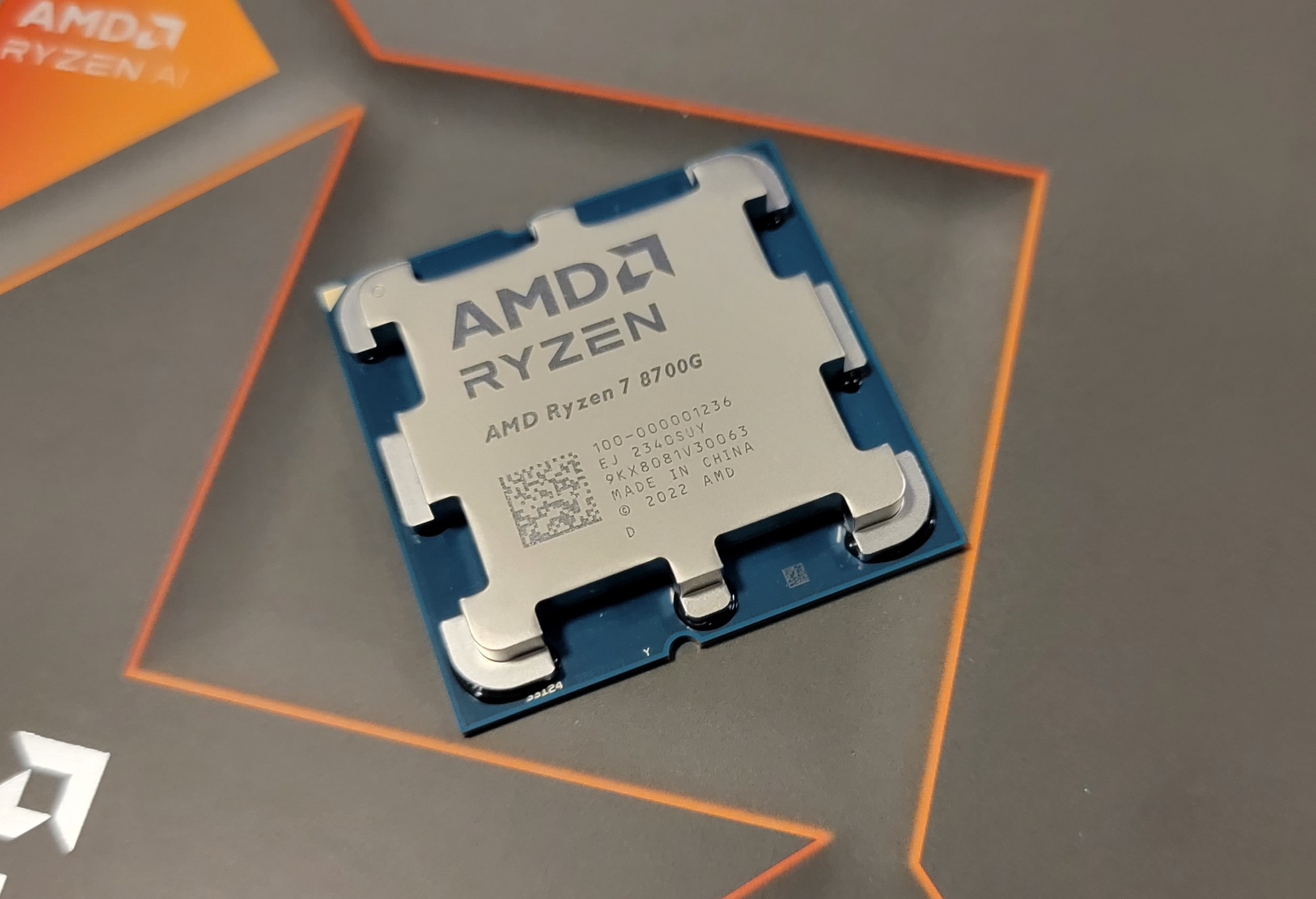Why you can trust Tom's Hardware
AMD's Ryzen 5000G series have been a fixture on our Best CPUs for gaming list for three years due to their convincing and clear value proposition for budget gamers on the lowest-end of the performance spectrum. Unfortunately, the long-awaited APU refresh, which comes in the form of the Ryzen 7 8700G and Ryzen 5 8600G, moves forward to the AM5 platform and doesn't offer the clear-cut value story of the older models, thus relegating them to a small niche audience.
The charts below outline three areas of performance: The geometric mean of our suite of integrated graphics tests at both 1920x1080 (FHD) and 1280x720 resolutions, the geometric mean of performance with a discrete GPU, and performance in single- and multi-threaded workloads.






AMD aims this chip squarely at budget gaming rigs that don't use a discrete GPU, so the first two slides with iGPU benchmarks are the primary focus. The Ryzen 7 8700G delivers impressive gen-on-gen gains due to the step forward to Zen 4 and RDNA 3 — overall, the chip is a whopping 81% faster than its predecessor, the Ryzen 7 5700G, in these benchmarks. However, the competing CPU+GPU combos offer much faster performance and often at lower prices and don't require quality-sapping upscaling to be competitive.
You could go with the Core i3-13100 and GTX 1650 and get a superior blend of price and performance without using upscaling, and you could even opt for the previous-gen Core i3-12100 and receive the same performance for about ~$30 less than the $325 we have listed in the chart. You could also pair the Core i3 with an RX 6600 and receive far more performance than the 8700G. Yes, this would result in faster gaming but slower performance in productivity work. However, those hunting for more grunt power could select a 13400+1650/6600 instead and still come out with a better price-to-performance ratio, albeit at the cost of a 15% performance loss in multi-threaded work. You could also opt for several AMD CPU+GPU combos, particularly on the AM4 platform, that could offer comparable or better performance for less cash.
And those savings come before we add the extra platform costs associated with the AM5 platform. As recently as this month, AMD has clearly stated that it will continue to bring new value processors to the AM4 platform due to the continued high pricing for DDR5, hinting that this condition will persist for some time. While DDR5 pricing has fallen from the stratospheric heights we saw at launch, it remains significantly more expensive than DDR4, and all signs point to it jumping in price again due to market conditions.
It's also important to note that the power use of an Intel CPU with an Nvidia GPU is substantially higher than the AMD APUs alone. AMD has a 65W TDP, with 88W peak power. Just the Nvidia GTX 1650 GDDR6 can use 75W, sometimes a bit more depending on the model, and the CPU adds another 65W.
The Ryzen 7 8700G does have impressive overclocking potential, especially in titles that benefit from increased memory throughput. The 8700G really benefits from increased throughput instead of low timings, so you don't have to splurge on the priciest EXPO kits, but DDR5 pricing also weighs in as a spoiler here.
To run the chip at stock settings, you can snag a 16GB kit of the officially supported DDR5-5200 for ~$65, but you can snag a 16GB DDR4-3200 kit for ~$35 that will run fine with Intel's competing platform or AMD's own AM4 options. Moving up to a sweet-spot 16GB DDR5-6000 EXPO kit brings you to around $80 bucks, but you'll need to step up to a 32GB kit to find DDR5-6400 options, and those start at ~$100.
AMD does have the distinction of being the first to offer a dedicated AI accelerator for the desktop PC, but that's a bit of a hollow win for now. The XDNA NPU focuses on power efficiency over raw compute horsepower, so it's a better fit for laptops than desktop PCs. Additionally, AMD finds itself in a chicken-and-egg scenario here, as precious few applications currently leverage the unit. That will change in the future, but it will go largely unused for now.
AMD's desktop APUs may be niche, but the company rules that niche without any serious competition. Intel seems uninterested in competing here, at least for now. AMD's addition of Hyper-RX with RSR and AFMF is a boon for budget gamers that are more willing to compromise on quality, but the performance of the competing CPU+GPU combos takes away some of that shine.
Unfortunately, the Ryzen 7 8700G suffers from not only the pricing of the chip — it needs a serious price cut to be competitive with CPU+GPU combos — but also from the nagging price problems with DDR5 and AM5 motherboards that have plagued AMD's new platform since the launch of the Ryzen 7000 series.
Combining DDR5 pricing with the small premiums that you'll still pay for even entry-level AM5 motherboards scuttles the Ryzen 7 8700G's value proposition for budget gaming rigs, leaving it as an increasingly niche product for those solely interested in building a high-performance system without a discrete graphics card, such as some SFF and passively-cooled system builds.
- MORE: AMD vs Intel
- MORE: Zen 4 Ryzen 7000 All We Know
- MORE: Raptor Lake All We Know
Get Tom's Hardware's best news and in-depth reviews, straight to your inbox.

Paul Alcorn is the Editor-in-Chief for Tom's Hardware US. He also writes news and reviews on CPUs, storage, and enterprise hardware.
-
usertests AMD Ryzen 7 5700G Hyper-RX, Power Consumption, Overclocking, Test SetupReply
Hyper-RX -> HYPR-RX
"The Ryzen 7 8700G utterly destroys the previous-gen Ryzen 7 8700G"
This review appears to be much more favorable to the 8700G. AnandTech did all testing at DDR5-5200.
Gamers Nexus found an issue with STAPM being enabled and degrading performance. That's Skin Temperature Aware Power Management, which obviously is not relevant to desktop APUs in a desktop computer.
There have been good bundles in the US with 7600X/7800X3D + motherboard + DDR5. Micro Center obviously but also Newegg.
https://slickdeals.net/f/17261224
If you do live near a Micro Center, take note of the stupidly low open box prices on DDR5-6000 kits. These returns aren't happening because the memory is bad. Maybe it's because they were included in so many bundles:
https://www.microcenter.com/category/4294966965/desktop-memory-ram?storeid=181 -
suryasans I will wait another year to buy Ryzen 8000G series as these APUs are still not a good value in terms of price/performance.Reply -
suryasans The included AI accelerator needs to be exposed in Gaming. It Will become a break through if the Ryzen 8700G GPU+NPU can be combined with discrete Graphics like Radeon RX 7600 to accelerate ray tracing effects in Gaming in the same FPS like Ray tracing effects disabled.Reply -
logainofhades For the price of an 8700g, 32gb ddr5 ram, and motherboard, you could build something like a 5700x, 32gb ddr4, b550 board, and an RX 6600, that would destroy the IGP in the 8700g. The price is simply too high.Reply -
jxdking 8700G is weird.Reply
Only with half the L3 cache of 7700x, it doesn't perform well in game even with a dgpu. -
logainofhades Replyjxdking said:8700G is weird.
Only with half the L3 cache of 7700x, it doesn't perform well in game even with a dgpu.
Some of those issues may be related to what GN discovered, as mentioned earlier. -
Tom Sunday Reply
The kids in their 'VANS T-Shirts' at GameStop are of a different opinion regarding all of the hoopla being now offered on the various tech channel reviews. Their argument is that the 8700G will not in real life have the same juice or capability of a (2019) GTX 1650 mobile and which so far allowed them playing quite satisfactory 80%+ of their mostly outdated and now starkly reduced on-sale games. And no matter what AMD is now promising the new 'Phoenix' chips are being capable off!suryasans said:I will wait another year to buy Ryzen 8000G series as these APUs are still not a good value in terms of price/performance.
For me these new Phoenix editions are essentially pointless as well. The three-star rating here in way telling the story! The Phoenix line I also think represents a niche product and the niche here is even smaller than with the once mighty Threadripper. Making me wonder why AMD would even bring this kind of new product to the market! Talking about niches:
Office PC: Too much GPU performance
Gaming PC: Much too little GPU performance
Parents PC: Too much GPU performance
Multimedia PC: Marginal at best
Children's PC (simple games): PossibleAccording to current rumors, Zen5 x3D will not come onto the market until 2025 and which would be my first consideration all things considered. Finally it will be curious to see in see how AMD sells or will market these new APUs through their strategic partners. -
usertests Reply
16 TOPS is weak. It has an efficiency advantage in laptops when it can be used. I don't think there's any chance that it can make upscaling or raytracing better.suryasans said:The included AI accelerator needs to be exposed in Gaming. It Will become a break through if the Ryzen 8700G GPU+NPU can be combined with discrete Graphics like Radeon RX 7600 to accelerate ray tracing effects in Gaming in the same FPS like Ray tracing effects disabled.
We'll see how XDNA 2.0 does at a significantly higher 45-50 TOPS. But I would still bet that it is not utilized by games anytime soon, or for offloading functions that are already handled by a dGPU. (I would love to be proven wrong, I still think it's a neat accelerator to have.)
Should be interesting to see how Strix Point does with increased 24 MiB L3 cache, but also a dual-CCX design.jxdking said:8700G is weird.
Only with half the L3 cache of 7700x, it doesn't perform well in game even with a dgpu. -
artk2219 AM5 really does need a cost reduction on the chipset, to help lower motherboard pricing since you cant do much about the RAM cost. Hopefully that can be addressed whenever they release the x700 series, i'm sure theyre also not worrying about it as its selling anyway, even with the high price. In the long run it's likely not sustainable, hopefully they figure that out before they have another socket 939 moment.Reply
